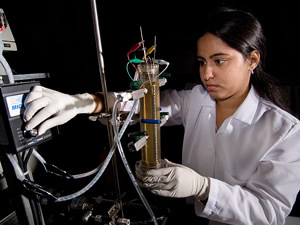Archana Venkataramanan, an environmental engineering graduate student with the University of Houston Cullen College of Engineering, received a $5,000 fellowship from the Ivanhoe Foundation for her research on drinking water purification.
The Ivanhoe Foundation grants fellowships deserving students from developing countries. To qualify, students must be studying at a U.S. university for a practical Master of Science degree in engineering or science, with an emphasis on water resources.
Archana was nominated by Dennis Clifford, professor of environmental engineering and director of the EE graduate program. The fellowship will help fund her research with Clifford on an innovative process to remove viruses from drinking water called electrocoagulation microfiltration (EC-MF).
A bench-scale electrocoagulation unit with a 260-mL active volume, consisting of iron anodes and stainless steel cathodes, was specially designed and developed for this research.
“When a current is passed through the EC-MF unit, the pure iron anodes produce ferric iron. This reacts with the water to form a ferric hydroxide precipitate that attracts the viruses to its surface,” said Archana. “The water is then micro-filtered to remove the iron particles with viruses attached.”
The conventional method for virus removal from water is chemical coagulation followed by microfiltration (CC-MF), which has been used for nearly a decade. According to Archana, however, this method reduces the water pH and consumes its alkalinity, causing the water to become acidic. Electrocoagulation preserves the pH of the water while, in addition, eliminates the use of corrosive chemicals. These benefits, along with the small, robust nature of the unit, make the method preferred over the more conventional chemical method.
Originally, Clifford and Shankar Chellam, associate professor of environmental engineering, received a grant to study the EC-MF process for emergency water supplies in remote, drought-stricken, or war-torn areas. EC-MF is ideal for this use because the process is readily incorporated into transportable drinking water systems.
“Previous research in our laboratory has shown that EC-MF out-performs CC-MF for virus removal in synthetic water,” said Archana. “My objective is to study the working of EC-MF in natural water, Lake Houston water, with natural organic matter, turbidity and other contaminants present.”
